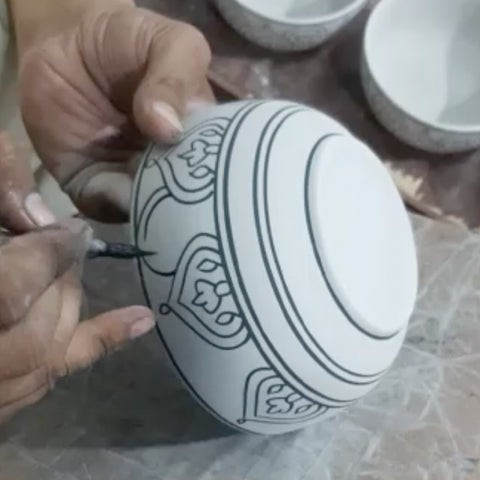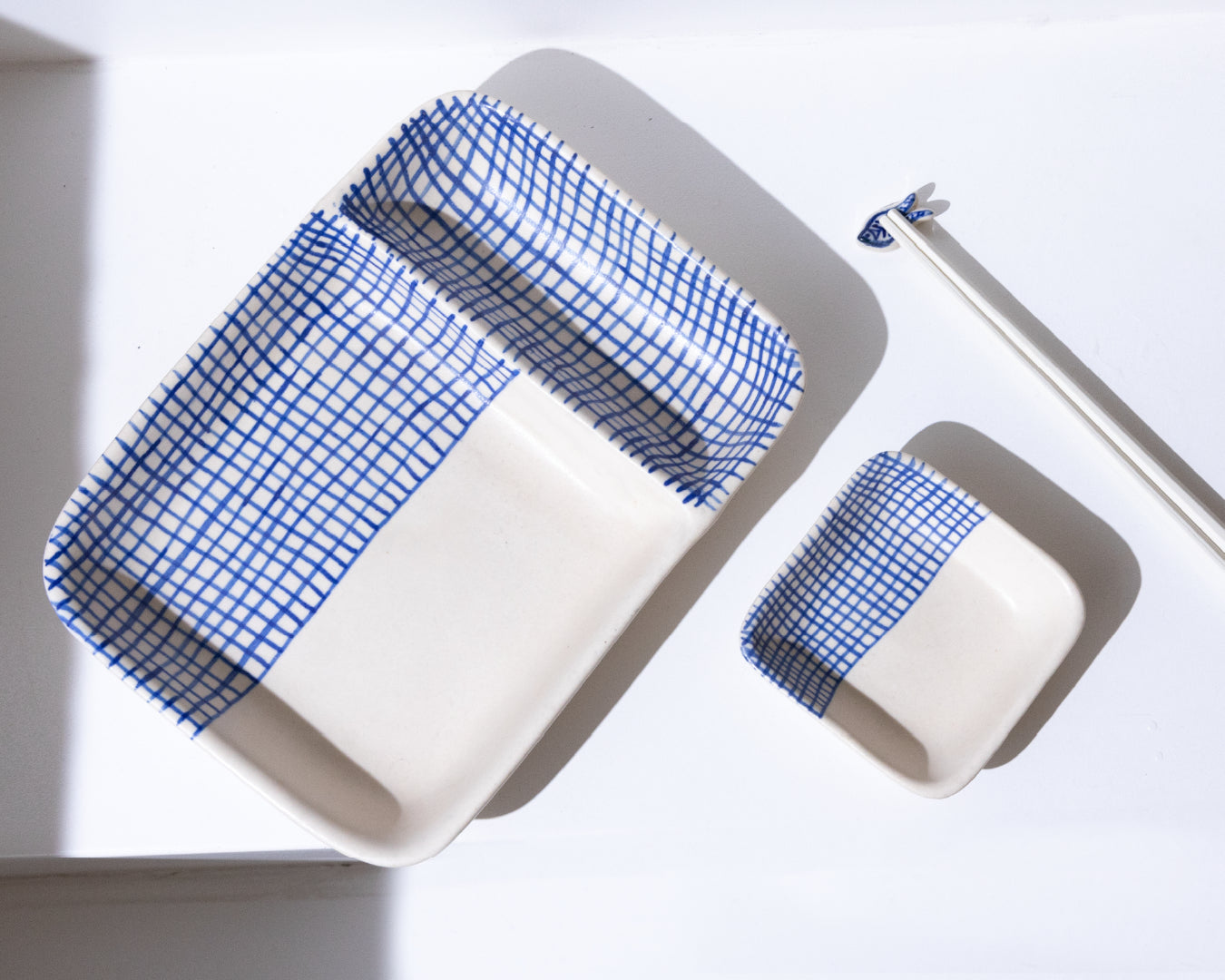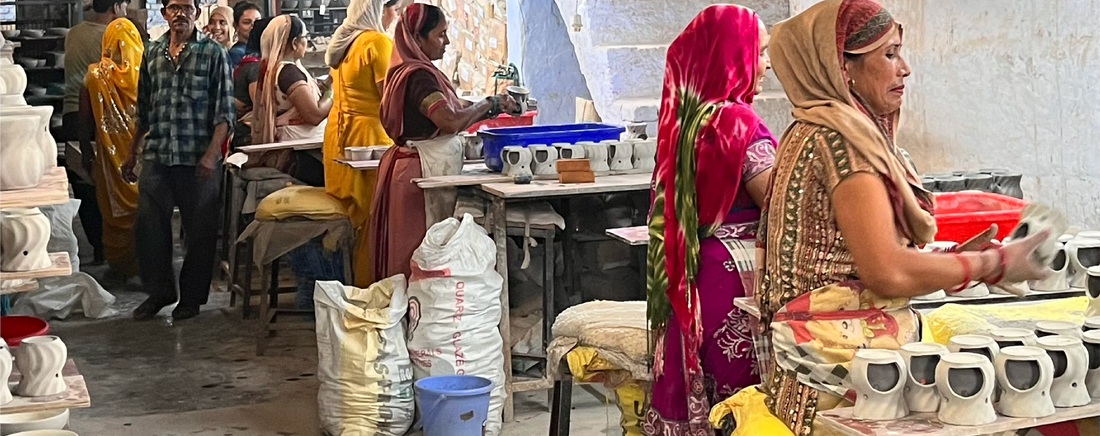For thousands of years ceramics have played a role, in history. They have adorned civilizations. Withstood the test of time from vessels to intricate works of art. In this exploration we will delve into the captivating world of ceramics focusing on the town of Khurja in India. Here this ancient craft has transformed into a legacy of creativity and tradition.

The Allure of Ceramics: Crafting Beauty and Utility
Ceramics encompass a range of items made from clay that is hardened through heat—a term derived from the word 'keramikos' which means 'of pottery.' The versatility of ceramics knows no bounds; it ranges from porcelain to stoneware. The process involves shaping clay drying it out firing it in kilns and applying glazes – each step requiring skill and precision.
Beyond functionality ceramics have evolved into a form of expression. From amphorae to dinnerware sets they strike an exquisite balance between form and function – serving both practical purposes and pleasing aesthetics.
Khurja: A Potter's Haven in Time
Situated in Uttar Pradesh Indias heartland lies Khurja – an embodiment of the lasting legacy held by ceramics. With a history dating back to the century this town has thrived as a center, for pottery and ceramics.The ceramics produced in Khurja are well known for their colors, designs and meticulous artistry. The skilled artisans of the town have perfected their craft over generations preserving methods while incorporating contemporary influences. This has resulted in a combination of heritage and innovation that characterizes Khurja ceramics.

A Glimpse into Khurja's Ceramic Heritage
Khurja's ceramic tradition is deeply rooted in the Mughal era, where the town became a prominent center for crafting tiles and pottery. Over the years, the artisans of Khurja have perfected the art of hand-painting, using techniques that create intricate designs on pottery.
The distinctive blue pottery of Khurja, often adorned with floral motifs and geometric patterns, reflects the town's historical ties to Persian and Central Asian art. The vibrant color palette, ranging from cobalt blue to emerald green, adds to the visual richness of Khurja ceramics.

The Ceramic Process Unveiled
Preparing the Clay:
The main raw material used for ceramic pottery is clay procured from varies places like Kerala, Rajasthan, Delhi, Bikaner, Bihar, and Ahmedabad. The clay is mixed with other materials like quartz, potash feldspar, china clay and ball clay procured from Jaipur, Ahmedabad and Bikaner. All these raw materials are mixed in a defined ratio and grinded in a Ball-mill equipment for around 10 hours to get homogenous mix of clay dough.
Clay Molding Process:
Molding process is generally done for bigger products like vases and pots. Mold of required article with the product cavity is prepared using Plaster of Paris (POP). Clay is mixed in a liquid solution with no lumps as material. Clay solution is poured into the mold till the solution fills the cavity in the mold. Mold box is shaken/rotated/tilted gently to avoid air bubbles and excess clay liquid solution is dispensed out. Molded product is elected with the help of a blade from the rim and other surface of the mold after settling time. Products are kept to dry in room temperature for a day.
Jigger and Jolly Process:
In this process the products are made with an equipment called Jigger and jolly, contains a die in jigger and a cavity in jolly to shape the clay. Jigger equipment consists of a movable handle which holds the die and a base to place clay dough whereas jolly equipment is same as jigger equipment but the base is to hold the cavity shaped bowl. A thick dough of clay with more elasticity is used in this process.
The holder is meant to hold different shapes of dies and fed against the clay dough kept on a rotating base to take the corresponding shape. Die on handle helps the clay dough to take shape by spreading on the base surface. Base plate come with a mechanism of replacing with another base plate on a base which helps to mass produce. Product is removed from the base and kept to settle to remove moisture on the base. Further it is taken from the base and kept to dry in room temperature.
Smoothening Process:
Surface of dried products are given finish by sanding with sand. Cracks developed during the molding process are also closed/filled with clay and allowed to dry followed by sanding.
Painting Process:
Mughal art and normal painting with motifs are the main paintings done on products. Mughal art is painted with cobalt-blue color followed by a colorless lead glazing, whereas other category is drawing motifs like floral or geometric patterns drawn on the outer surface with oxide colors followed by a colorless lead glazing. Painting on a plain surface adds value to ceramic products.
Sticker Ornamentation:
Sticker ornamentation is another method of adding value to ceramic products like coffee mugs and crockeries, mainly used for advertising, better aesthetics and to display corporate identity.
Glazing process:
Glazing is a glossy layer fused to ceramic objects which serves to color, decorate, waterproof and to strengthen the underlying ceramic. Glazes can be transparent, opaque, translucent, glossy, semi- matte and matte finish. Glazes are made up of three basic elements, glass former, melter and binder.
Firing Process:
It’s a process done in a covered kiln. Earlier brick kiln were used but now a days it is replaced by gas or electric kiln with a temperature control technology which is easy for the artisans to operate and to avoid the number of damages. Firing in electric kiln helps to spread the heat uniformly in a given time.

Preserving Tradition, Embracing Innovation
In Khurja, the art of ceramics is not frozen in time but rather a living tradition that adapts to the demands of the present. Modern Khurja ceramics include a diverse range of products, from traditional kitchenware to contemporary decorative pieces. This versatility has allowed the town's artisans to reach a global audience while maintaining the authenticity of their craft.
The advent of e-commerce has further facilitated the accessibility of Khurja ceramics, enabling people from different corners of the world to bring a piece of this rich heritage into their homes. The intersection of tradition and innovation has become a hallmark of Khurja's ceramic industry.
Conclusion: Khurja Ceramics - Where Art and Heritage Converge
As we navigate the fascinating world of ceramics, Khurja emerges as a beacon of artistic brilliance and cultural heritage. The town's ceramics not only showcase the skill of its artisans but also tell a story of resilience and adaptability.
In every carefully painted stroke and meticulously crafted form, Khurja's ceramics invite us to appreciate the beauty of tradition and the dynamism of a craft that has stood the test of time. As we explore the intricacies of Khurja ceramics, we find ourselves not just witnessing art but becoming part of a legacy that continues to shape the narrative of ceramics in the 21st century.
explore more at www.theindianrose.studio


